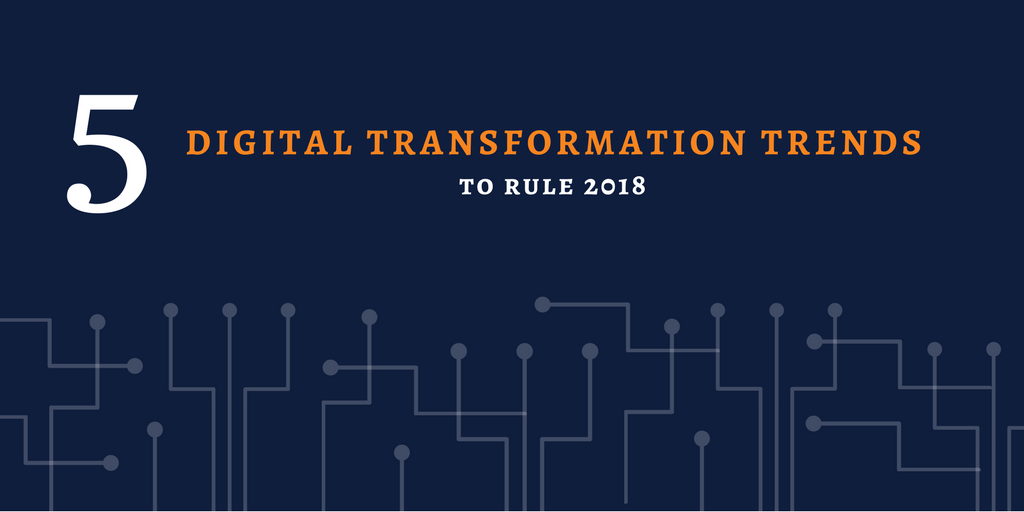5 Top Digital Transformation Trends in 2018
What’s hot in digital seems to be changing rapidly. Digital Trends has covered headlines for years now, witnessing a tremendous growth firsthand. An unending array of latest gadgets and concepts speak of the huge impact it has in hold for businesses. Last year, Amazon’s Alexa was the big thin, and that trend has not abated. Many companies are exploring new ways to incorporate digital trends into their products and services. The pace at which this takes place indicates that eventually every product, every service offered is going to be digitally clever and future-ready.
One of the top digital trends in 2018 is going to be smart home technology, which will continue to flourish this year. Intended to change the way we live, smart home concept includes the usual home appliances like refrigerators, toasters, and washers, and a whole range of home security devices to detect marauders invading your porch. Digital technology has a lot more to offer this year and here are the top digital transformation trends that are all set to rule 2018.
Blockchain Leaps Out of the Box
Blockchain is destined to transform entire world of business and the way how everything is carried out. Despite a shaky start other than in cryptocurrency, it is starting to take pace with as adoption happens elsewhere. The State of Delaware has passed a law that allows corporations use blockchain technology to maintain shareholder lists and corporate records. The UK-based digital bank Revolut is launching a virtual bank. All banking happens online, and its assets are built on blockchain. It just hit a million customers and plans to touch U.S. shores by 2018. Targeted blockchain applications are expected to continue to emerge in 2018.

Smartphone Gets Even Smarter
The so called Smartphone allows you stay connected in many other ways other than the traditional voice call. That’s all going to change with the introduction of AI and machine learning.
The usual Smartphone is about to get an intelligent upgrade in 2018. Mobile processors that are designed to handle AI technology are expected to hit the industry soon this year. Digital assistants will be there offering a more personalized service by anticipating your needs even before you could ask.
Siri, Alexa, Cortana, Bixby, these names look familiar. We talk to them as they were real people, saying “please” and “thanks” and rely on them for all kinds of things, giving us directions, controlling our gadgets, or reminding to take our prescription drugs. But we have just touched the surface of what personal digital assistants can do.
Think of the way your digital assistant helps you save time by letting you know the traffic condition, the shortest route and the time it would take to reach your destination. All your questions answered even before you ask. More such location-aware platforms are expected this year.
The Touchless Interface
The UI is our entry to the world where tech gadgets serve us inherently. But until now most of these gadgets need some kind of physical interaction to work. All this is going to change this year, with the entry of touchless interface.
Virtual assistants like Alexa and Siri have proven that there is no need to rely on our thumbs and fingers anymore. But this way of interaction is about to change this year.
Imagine picking up an empty pizza box and saying “Alexa, order this” and it being ordered right away without you as Alexa understands what you’re holding. Other such customized responses based on who is asking, are already here and will become more prevalent in 2018.
In the coming years, touchless interface is sure to take us to tomorrowland where the tap and swipe will become history.
Cloud Computing Gets Edgy
We are so familiar to Cloud Computing that we simply feel strange about this next tech trend “Edge Computing” is set to transform the way we see cloud computing in 2018.
As devices get more powerful, they will require large streams of data to operate, which will make cloud computing too slow. Even with 5G, there will still be chances of latency in the connection.
For instance, you’re in a self-driving M25 with your baby in the back seat and need a quick slow down, but your car lost connection to the cloud. The danger is obvious. You can’t afford to wait until the data travels from your car to a central server to make that decision to slow down. So, your car becomes a data center of its own, making such decisions locally, but sending data home to improve the operation of other self-driven vehicles.
Reality Gets Virtual
Adoption of VR and AR technologies has been slow due to the high cost, and the fact people who use such devices suffer from motion sickness. This is about to change in 2018. Major companies like Apple and Google are planning to get it to mainstream. AR is evolving more rapidly than VR.
Imagine shopping with an AR app that allows you to take photos of the items in the aisle and instantly reveals prices, ingredients, reviews, coupons, promotions, discounts, and even buy the product within the app.
Expect to see more such exciting innovations in the computing landscape in 2018, potential innovations that were long talked about, becoming a reality.
